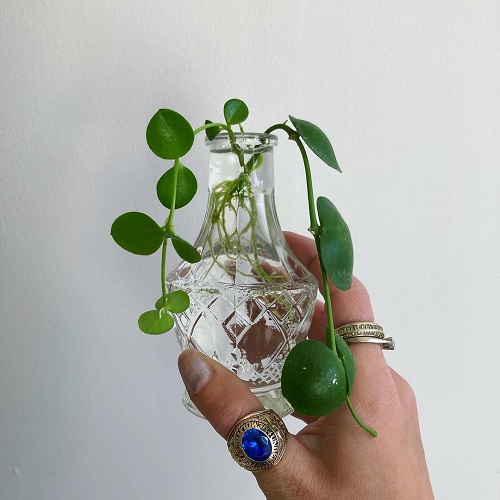Dischidia Nummularia stands out with its coin-like foliage and bushy trailing stems. Let’s have a look at how to grow it.
Dischidia Nummularia, also known as the string of nickels, is a beautiful trailing plant that is easy to care for and propagate. In this guide, we will cover all the essential steps you need to know to grow and maintain it.
Botanical Name: Dischidia nummularia
Common Name: String of nickels, Button orchid
Dischidia Nummularia Plant Information
Dischidia Nummularia is a succulent that earned its name because of its unique appearance. Its small, round leaves resemble tiny coins that dangle on a cord. Native to tropical regions in India, Australia, and Asia, this epiphyte can grow on tree trunks, branches, and rocky terrains in its natural habitat.
The leaves of the plant come in varying shades of pale green, silvery, or bronze. It thrives in a humid and warm environment with plenty of hardscapes for climbing.
These vining succulents are easy to grow and care for, making them a great choice for an attractive houseplant that can be grown in a hanging basket.
Learn About Growing Dischidia Major here
Propagating Dischidia Nummularia

Propagating this Dischidia is easy peasy. All you need is a healthy stem cutting. Let it callous for a day, and then place in moist sphagnum moss. Keep near a bright window and give it a good mist when the moss appears dry.
In about 2-3 weeks, you’ll see the roots, and the plant will start establishing itself. Give a couple more weeks and when you see a proper root system, transplant it into a pot with soil. That’s it!
Learn How to Grow Dischidia Geri in the Pots here
Requirements for Growing Dischidia Nummularia

Sunlight
The plant loves bright light, which is indirect. So keep it near a south-facing window with curtains so you can give it shade during the harsh afternoon sun. 2-3 hours of morning sun works.
In the garden, go for a shaded area so it is not affected by intense and hot afternoon sunlight.
Soil
Dischidia Nummularia is NOT actually grown in traditional soil, but rather a well-draining, chunky potting mix. Here’s how to make it.
- 2 parts Orchid bark for structure, drainage, and air circulation.
- 1 part Perlite for drainage and preventing waterlogging.
- 1 part Coco coir chips for moisture retention and aeration.
Mix all of these well in a container and transfer them to the pot. You can also add a bit of charcoal to prevent fungal growth.
Water
Water the plant only when the topsoil feels a little dry to the touch. Do not moisten the growing medium on a daily basis.
During winter months, reduce the frequency of watering, allowing the soil to dry out completely between waterings.
Humidity and Temperature
It grows best in the range of 60 to 85°F (15-29°C). The plant will also tolerate some lower temperatures, but it should not drop below 55°F (13°C).
Dischidia Nummularia also thrives in high humidity, so misting the leaves regularly will help keep the plant healthy and happy.
Dischidia Nummularia Care

Fertilizer
The plant does not require much fertilizer. To boost the growth, use a balanced liquid fertilizer after diluting it to 1/2 of its strength once in 5-6 weeks.
Do not feed the plant in the winter months.
Pests and Diseases
Nummularia Dischidias need air circulation and a well-draining potting mix. If that’s covered, you won’t have to worry about pests much. You might see the occasional mealybug or fungal gnats, so use insecticidal soap.
Also, don’t overwater your plant because it will lead to mushy, brown roots (root rot). If that happens, repot the plant into a new pot with fresh potting mix.



